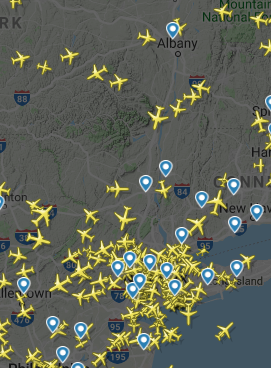The goal of this assignment is to practice concurrent and distributed programming using an actor programming language, such as SALSA.
You are to analyze flights' data from ADS-B Exchange, in particular, flights 2, 20, 200, 1500 nautical miles (nmi) around JFK Airport to detect potential Near Mid-Air Collisions (NMAC). Your program needs to compute the following:
- Closest Flights: Compute the pair of flights that minimize pairwise distance at the current time.
- Closest DCPA: Compute the pair of flights that minimize the distance at closest point of approach (DCPA), asuming constant heading, horizontal and vertical airspeed.
- Soonest NMAC: Compute the pair of flights that minimize the time to closest point of approach (TCPA) for flight pairs with DCPA ≤ 0.66 nmi, asuming constant heading, horizontal and vertical airspeed.
For each computation, output multiple answers if there are ties. For example, when computing DCPA or TCPA, if there are multiple pairs with the same minimum pairwise value, output all pairs.
More information on ADS-B can be found in the associated ADS-B Data Field Descriptions and ADS-B Exchange Forum.
More information about DCPA and TCPA calculation can be found in A Family of Well-Clear Boundary Models for the Integration of UAS in the NAS, pp 3.
You are given an ADS-B text file with a flight per line, detailing Id, Latitude, Longitude, Trak (0º=North, 90º=East), Horizontal Speed (knots), Altitude (feet), Vertical Speed (feet per minute). Please remove duplicate and empty-value entries in your program. Your output should look as follows:
d1 // minimal pairwise distance id1 id2 id3 id4 ... d2 // minimal pairwise DCPA id1 lat1 long1 alt1 id2 lat2 long2 alt2 ... t3 // minimal pairwise TCPA id1 lat1 long1 alt1 id2 lat2 long2 alt2 ...where
d_idenotes a distance (nmi),
t_idenotes a time (seconds) and
id_idenotes a flight id, and (lat,long,alt) corresponds to the position of each aircraft at DCPA/TCPA. You may use the formula for destination point given distance and bearing from starting point available at https://www.movable-type.co.uk/scripts/latlong.html, and assume a constant vertical speed.
Part 1 - Concurrent Solution
Write an actor-based solution to the NMAC detection problem.
Part 2 - Distributed Solution
Write a distributed NMAC solution. Note that in this case, the actors must communicate over a network although you do not necessarily have to run each actor on a separate machine. When using SALSA, your solution will be distributed if you make use of universal actors.Time-Saving Hints
- For reference, please see the SALSA webpage, including its FAQ. Read the tutorial and a comprehensive example illustrating distributed programming in SALSA.
salsacandsalsaare UNIX aliases or Windows batch scripts that runjavaandjavacwith the expected arguments: See .cshrc for UNIX, and salsac.bat salsa.bat for Windows.- To run the distributed program, first, run the name server and the theaters:
[host0:dir0]$ wwcns [port number 0] [host1:dir1]$ wwctheater [port number 1] [host2:dir2]$ wwctheater [port number 2] ...
wherewwcnsandwwctheaterare UNIX aliases or Windows batch scripts: See .cshrc for UNIX, and wwcns.bat wwctheater.bat for Windows. Make sure that the theaters are run where the actor behavior code is available, that is, thepa2directory should be visible in directories:host1:dir1andhost2:dir2. Then, run the distributed program as mentioned above. - The theaters all cache actor behaviors. Restart all the theaters each time changes are made to the code.
- The module/behavior names in SALSA must match the directory/file hierarchical structure in the
file system. e.g., a
NMACbehavior should be in a relative pathpa2/NMAC.salsa, and should start with the linemodule pa2;. - Messaging is asynchronous.
m1(...);m2(...);does not implym1occurs beforem2. - Notice that in the code
m(...)@n(...);,nis processed after m is executed, but not necessarily after messages sent insidemare executed. For example, if insidem, messagesm1andm2are sent, in general,ncould happen beforem1andm2. - (Named) tokens can only be used as arguments to messages.
Due Date: March 26th, 6:00PM
Grading: The assignment will be graded mostly on correctness, but code clarity / readability will also be a factor (comment, comment, comment!).
Submission Requirements: Please submit a ZIP file with your code, including a README file. In the README file, place the names of each group member. Your README file should also have a list of specific features / bugs in your solution. Your ZIP file should be named with your LMS user name(s) as the filename, either userid1.zip or userid1_userid2.zip. Only submit one assignment per pair via LMS.
